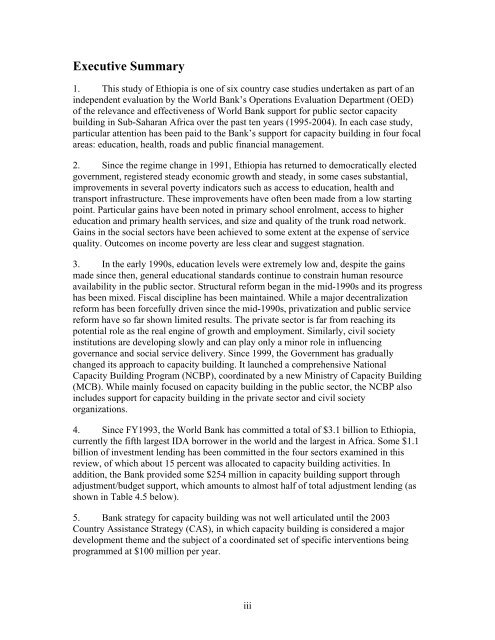An Independent Review of World Bank Support to ... - DAG Ethiopia
An Independent Review of World Bank Support to ... - DAG Ethiopia
An Independent Review of World Bank Support to ... - DAG Ethiopia
You also want an ePaper? Increase the reach of your titles
YUMPU automatically turns print PDFs into web optimized ePapers that Google loves.
Executive Summary1. This study <strong>of</strong> <strong>Ethiopia</strong> is one <strong>of</strong> six country case studies undertaken as part <strong>of</strong> anindependent evaluation by the <strong>World</strong> <strong>Bank</strong>’s Operations Evaluation Department (OED)<strong>of</strong> the relevance and effectiveness <strong>of</strong> <strong>World</strong> <strong>Bank</strong> support for public sec<strong>to</strong>r capacitybuilding in Sub-Saharan Africa over the past ten years (1995-2004). In each case study,particular attention has been paid <strong>to</strong> the <strong>Bank</strong>’s support for capacity building in four focalareas: education, health, roads and public financial management.2. Since the regime change in 1991, <strong>Ethiopia</strong> has returned <strong>to</strong> democratically electedgovernment, registered steady economic growth and steady, in some cases substantial,improvements in several poverty indica<strong>to</strong>rs such as access <strong>to</strong> education, health andtransport infrastructure. These improvements have <strong>of</strong>ten been made from a low startingpoint. Particular gains have been noted in primary school enrolment, access <strong>to</strong> highereducation and primary health services, and size and quality <strong>of</strong> the trunk road network.Gains in the social sec<strong>to</strong>rs have been achieved <strong>to</strong> some extent at the expense <strong>of</strong> servicequality. Outcomes on income poverty are less clear and suggest stagnation.3. In the early 1990s, education levels were extremely low and, despite the gainsmade since then, general educational standards continue <strong>to</strong> constrain human resourceavailability in the public sec<strong>to</strong>r. Structural reform began in the mid-1990s and its progresshas been mixed. Fiscal discipline has been maintained. While a major decentralizationreform has been forcefully driven since the mid-1990s, privatization and public servicereform have so far shown limited results. The private sec<strong>to</strong>r is far from reaching itspotential role as the real engine <strong>of</strong> growth and employment. Similarly, civil societyinstitutions are developing slowly and can play only a minor role in influencinggovernance and social service delivery. Since 1999, the Government has graduallychanged its approach <strong>to</strong> capacity building. It launched a comprehensive NationalCapacity Building Program (NCBP), coordinated by a new Ministry <strong>of</strong> Capacity Building(MCB). While mainly focused on capacity building in the public sec<strong>to</strong>r, the NCBP alsoincludes support for capacity building in the private sec<strong>to</strong>r and civil societyorganizations.4. Since FY1993, the <strong>World</strong> <strong>Bank</strong> has committed a <strong>to</strong>tal <strong>of</strong> $3.1 billion <strong>to</strong> <strong>Ethiopia</strong>,currently the fifth largest IDA borrower in the world and the largest in Africa. Some $1.1billion <strong>of</strong> investment lending has been committed in the four sec<strong>to</strong>rs examined in thisreview, <strong>of</strong> which about 15 percent was allocated <strong>to</strong> capacity building activities. Inaddition, the <strong>Bank</strong> provided some $254 million in capacity building support throughadjustment/budget support, which amounts <strong>to</strong> almost half <strong>of</strong> <strong>to</strong>tal adjustment lending (asshown in Table 4.5 below).5. <strong>Bank</strong> strategy for capacity building was not well articulated until the 2003Country Assistance Strategy (CAS), in which capacity building is considered a majordevelopment theme and the subject <strong>of</strong> a coordinated set <strong>of</strong> specific interventions beingprogrammed at $100 million per year.iii
















